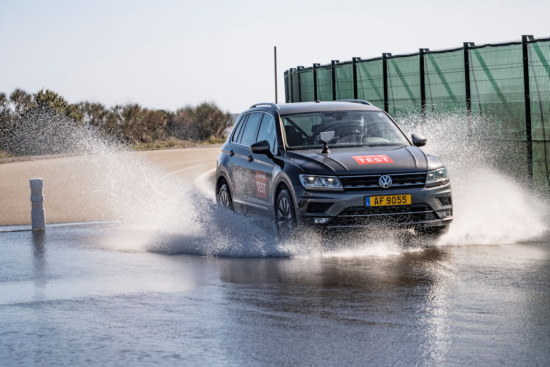Tyre test praise for Bridgestone LM005
 The associations tested in wet, snowy and dry conditions (Photo: ACE/Konstantin Tschovikov)
The associations tested in wet, snowy and dry conditions (Photo: ACE/Konstantin Tschovikov)
In its latest joint winter tyre test, motoring association Auto Club Europa (ACE) describes the Bridgestone Blizzak LM005 as being “close to the perfect winter tyre,” having displayed “more than rock solid performance” in all test disciplines. The Bridgestone tyre was the only product to gain ACE’s ‘very recommendable’ rating. The association gave a ‘recommendable’ rating to six tyres and ‘conditionally recommendable’ to one product but declared a further two ‘not recommendable’.
This year, European motoring clubs ACE, ARBÖ und GTÜ examined premium, mid-range and budget tyres in the SUV dimension 235/55 R18. They fitted the ten brands of tyre to a VW Tiguan for testing and evaluated these in a range of conditions, with a particular emphasis upon performance on wet, snowy, and to a lesser extent, dry surfaces. Testing took place at the Goodyear proving ground in Mireval, France and in Ivalo, Finland.
Wet braking & handling
ACE calls braking on wet roads from 80 km/h the “king of the disciplines” as it requires a supreme effort from the tyres. The best performer in the current test was the Hankook I*Cept Evo3 X with a braking distance of 30.4 metres. Most of the tested tyres came to a stop within 30 to 32 metres, the exceptions being the Austone Skadi SP-901 (38.8 metres) and Fortuna Winter SUV (41 metres). ACE comments that this extra braking distance “corresponds to the length of two short compact vans.”
The tyre testers also observed massive differences in handling on wet roads. They credited the tyres from Bridgestone, Goodyear and Nokian as having the most precise steering and driving characteristics, but ACE adds that the other premium and quality tyre brands were also “on a well manageable level.” On the other hand, the motoring association considers the lower-priced tyres in the test “disappointing” and even refers to the handling delivered by the Austone and Fortuna tyres as a “disaster”. ACE further criticises both for providing insufficient grip and imprecise steering characteristics. “Our testers rated the handling of these tyres as dangerous for normal drivers,” shares ACE.
Testing for straight and sideways aquaplaning revealed a wide range of performances, too. ACE comments that the Bridgestone Blizzak LM005 mastered both tests best of all, while the testers considered the Austone and Fortuna tyres susceptible to aquaplaning. The other tested tyres “showed a solid performance.”
Performance on snowy surfaces
In their winter testing, ACE, ARBÖ und GTÜ evaluated tyres when accelerating, driving and braking on snow-covered roads. Acceleration wasn’t a problem for any of the test tyres and the results were close together. This was also the case when braking on snow from a speed of 35 km/h: The Bridgestone tyre came first with a stopping distance of 12.26 metres and the Austone came in second.
There were no outliers in the snow handling tests, either. ACE comments that the Austone tyre “surprisingly” delivered the same good level of performance as the Michelin candidate. “Both steered well on snow, had good lateral control and reacted quickly to changes in the road. Overall, they gave a good steering feel and were the best in this discipline.” The testers handed the wooden spoon in snow handling to the Sailun Ice Blazer Alpine Evo 1, which according to ACE “revealed slight weaknesses in grip and driving stability in curves, especially on uphill sections,” even though it was “controllable overall.” The remaining tyres formed a “solid midfield” in this discipline. The Goodyear and Nokian tyres showed minimal weaknesses in traction on uphill sections and in lateral control.
In dry conditions
Almost all tyres delivered “rock solid” braking on dry roads from 100 km/h. Only the Fortuna stepped out of line with a braking distance of 45.3 metres, almost five metres longer than the top result of 40.4 metres achieved by the Michelin Pilot Alpin 5 SUV. This corresponds to one car length and ACE comments that it is “clearly too much.”
When it came to handling on dry roads, several tyres showed their skills. The best in this discipline were the Hankook, Goodyear, Nokian, Pirelli, Bridgestone and Continental candidates, which all “steered precisely and guided safely in the curves.” The Michelin and Sailun tyres were both “slightly weaker” than the top group of six but still offered safe driving. The Fortuna and Austone tyres, on the other hand, made a weaker impression. ACE reports that both products “showed too much understeer, were more difficult to steer in bends and overall too spongy and imprecise to steer.”
Results
“The Bridgestone is close to the perfect winter tyre, showing more than rock solid overall performance in all disciplines, closely followed by the Hankook and Continental,” shares ACE. “The Sailun still achieved a conditionally recommendable rating, although it was also the loudest tyre in the test. At 74.77 decibels, it was even two decibels above the EU label value.”
As for the Austone and Fortuna tyres, ACE called these “completely disappointing.” The motoring association adds that “after a strong start on snow, they showed how dangerous it can be to have the wrong tyre when the weather changes. They fail the test completely under the given conditions.” ACE concludes by stressing that “when buying tyres, price should only be one criterion; road safety is more important.”




Comments